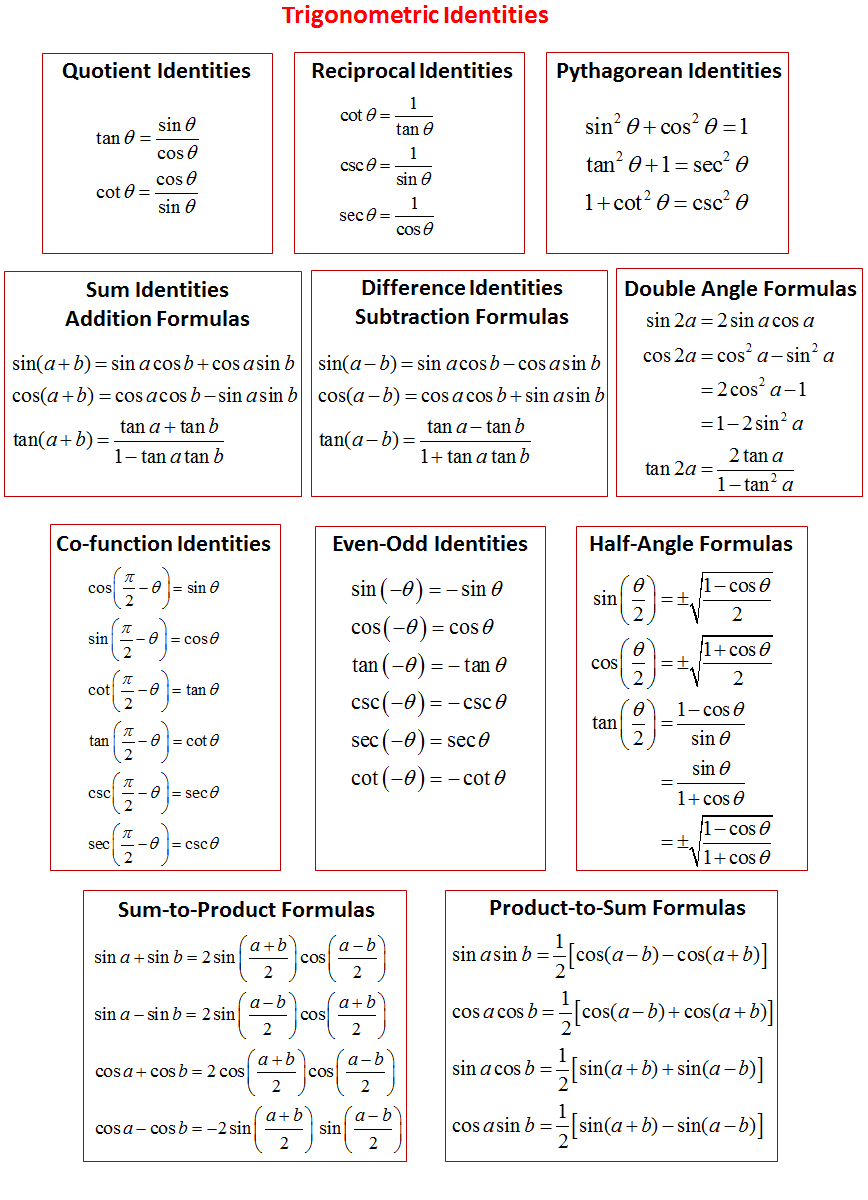Trigonometric Identities
Related Pages
Trigonometric Graphs
Lessons On Trigonometry
Trigonometric Functions
In these lessons, we cover trigonometric identities and how to use them to simplify trigonometric expressions.
Trigonometric identities (trig identities) are equalities that involve trigonometric functions that are true for all values of the occurring variables. These identities are useful when we need to simplify expressions involving trigonometric functions.
The following is a list of useful Trigonometric identities: Quotient Identities, Reciprocal Identities, Pythagorean Identities, Co-function Identities, Addition Formulas, Subtraction Formulas, Double Angle Formulas, Even Odd Identities, Sum-to-product formulas, Product-to-sum formulas.
Scroll down the page to learn how the different Trigonometric identities are derived and how they may be used.

Trigonometry Worksheets
Practice your skills with the following worksheets:
Printable & Online Trigonometry Worksheets
Quotient, Reciprocal and Pythagorean Identities
This video shows how to derive the Quotient, Reciprocal and Pythagorean identities.
Cofunction Identities
This video explains the cofunction identities and how to determine cofunctions given a function value.
Cofunction Identities - Solving Trigonometric Equations
This video explains how to use cofunction identities to solve trigonometric equations.
Sum and Difference Identities for Sine and Cosine
The cosine addition formula calculates the cosine of an angle that is either the sum or difference of two other angles. It arises from the law of cosines and the distance formula. By using the cosine addition formula, the cosine of both the sum and difference of two angles can be found with the two angles’ sines and cosines.
This video shows how to derive an identity for Cosine of a sum of two angles. It will use the unit circle definition for sine and cosine, the Pythagorean Identity, the distance formula between two points, and some algebra to derive an identity for cos(a + b)
How to use the formula for the cosine of the sum of two angles to derive the formulas for the cosine of the difference of two angles, the sine of the sum of two angles, and the sine of the difference of two angles?
Examples using the formula are provided.
How to use the sum and difference formula for cosine to find exact values of non-special angles?
Sum and Difference Identities for Sine and Cosine
More examples of using the sum and difference identities to find value other trig values.
Sine Addition Formula
Starting with the cofunction identities, the sine addition formula is derived by applying
the cosine difference formula. There are two main differences from the cosine formula: (1)
the sine addition formula adds both terms, where the cosine addition formula subtracts and
the subtraction formula adds; and (2) the sine formulas have sin-sin and cos-cos. Both
formulas find values for angles.
How to Prove the Addition and Subtraction Formula for sin(x+y) or sin(x-y)?
Using the Sine and Cosine Addition
Formulas to Prove Identities: Applying the cosine addition and sine addition formulas proves
the cofunction, add π, and supplementary angle identities. Using the formulas, we see that
sin(π/2-x) = cos(x), cos(π/2-x) = sin(x); that sin(x + π) = -sin(x), cos(x + π) = -cos(x);
and that sin(π-x) = sin(x), cos(π-x) = -cos(x). The formulas also give the tangent of a
difference formula, for tan(α - β).
How to use the sine and cosine subtraction formulas to prove the cofunction identities?
How to use the sine and cosine addition formulas to prove the cofunction identities?
Sum and Difference Identities for Tangent
Double Angle Identities
Double Angle Formulas
The double angles sin 2θ and cos 2θ can be rewritten as sin(θ + θ) and cos(θ + θ). Applying
the cosine and sine addition formulas, we find that sin 2θ = 2sin θ cos θ and cos 2θ =
cos2 θ - sin2 θ. cos 2θ = cos2 θ - sin2 θ.
Combining this formula with the Pythagorean Identity, cos2 θ + sin2 θ = 1,
two other forms appear: cos 2θ = 2cos2 θ - 1 and cos 2θ = 1 - 2sin2 θ.
How to use the sine and cosine addition formulas to prove the double-angle formulas?
The derivation of the double angle identities for sine and cosine, followed by some examples.
How to use the double-angle identities to determine function values
Sum to Product and Product to Sum Identities
How to use trig identities to rewrite trig expressions?
Half Angle Identities
The half angle identities come from the power reduction formulas using the key substitution α = θ/2 twice, once on the left and right sides of the equation. With half angle identities, on the left side, this yields (after a square root) cos(θ/2) or sin(θ/2); on the right side cos 2θ becomes cos θ because 2(1/2) = 1. For a problem like sin(π/12), remember that θ/2 = π/12, or θ = π/6, when substituting into the identity.
The derivations of the half-angle identities for both sine and cosine, plus listing the tangent ones. Then a couple of examples using the identities.
How to use the half-angle identities to determine function values?
Try out our new and fun Fraction Concoction Game.
Add and subtract fractions to make exciting fraction concoctions following a recipe. There are four levels of difficulty: Easy, medium, hard and insane. Practice the basics of fraction addition and subtraction or challenge yourself with the insane level.

We welcome your feedback, comments and questions about this site or page. Please submit your feedback or enquiries via our Feedback page.